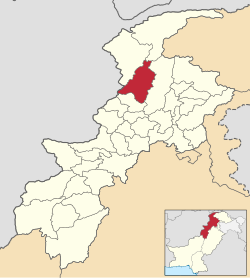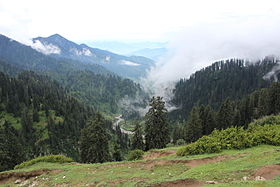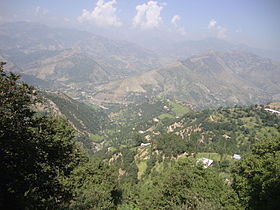Upper Dir District
Upper Dir District
ضلع دیر بالا | |
|---|---|
 Location of Upper Dir District (highlighted in red) in the Khyber Pakhtunkhwa map | |
| Country | |
| Province | |
| Division | Malakand |
| Established | 1996 |
| Headquarters | Dir |
| Government | |
| • Type | District Administration |
| • Deputy Commissioner | N/A |
| • District Police Officer | N/A |
| • District Health Officer | N/A |
| Area | |
| • Total | 3,699 km2 (1,428 sq mi) |
| Population | |
| • Total | 947,401 |
| • Density | 260/km2 (660/sq mi) |
| • Urban | 44,165 |
| • Rural | 902,256 |
| Time zone | UTC+5 (PST) |
| Number of Tehsils | 6 |
| Main language(s) | Pashto (93%),[2]: 21 Gawri |
| Website | dirupper |
Upper Dir District (Pashto: بر دير ولسوالۍ, Urdu: ضلع دیر بالا) is a district in Malakand Division of Khyber Pakhtunkhwa province in Pakistan. The city of Dir is the district headquarters. Badogai Pass connects it to Utror.
At the time of independence, Dir was a princely state ruled by Nawab Shah Jehan Khan. It was merged with Pakistan in 1969 and later on declared as a district in 1970. In 1996, the Dir District was divided into Upper and Lower Dir districts. This district is situated in the northern part of Pakistan. It borders Chitral district and Afghanistan on the north and northwest and Swat district to the east, and on the south by Lower Dir District.People of Dir are very hospitable. Dir is also called The Land of Hospitality and Brave People.

History
The British Raj honored Muhammad sharif Khan as Nawab of Dir in 1898 . By declaring his allegiance to the British Raj, Khan/Nawab, once exiled to Afghanistan by Umara Khan Mastkhel was seated as Nawab of Dir. He was succeeded by his son Nawab Aurang Zeb in 1904, who ruled until his death in 1925. His son Sir Shah Jehan succeeded him and ruled the state for 35 long years. He was dethroned and kept in house arrest in Lahore until his death in 1966 . He was succeeded by Mohammad Shah Khisro Khan. He left all the business at the mercy of his advisor, a man deputed by the Govt:of Pakistan to mould the state into a settled district through gradual implementation of laws. In 1969, it was merged as a district with Khyber Pakhtunkhwa. In 1996, Dir District was divided into two districts-Lower and Upper Dir- with Timergara and Dir as their respective headquarters.
Demographics
At the time of the 2017 census the district had a population of 947,401, of which 466,594 were males and 480,766 females. Rural population was 903,301 (95.35%) while the urban population was 44,100 (4.65%). The literacy rate was 46.09% - the male literacy rate was 64.84% while the female literacy rate was 28.85%. 471 people in the district were from religious minorities.[1]
Pashto was the predominant language, spoken by 90.78% of the population. Other languages, mainly various Kohistani languages, are spoken by 8.60% of the population.[1]
Administration
Upper Dir District has 3 Tehsils.[3]
National Assembly
This district is represented by one elected MNA (Member of National Assembly) in Pakistan National Assembly. Its constituency is NA-5 (Upper Dir).[4]
| Member of National Assembly | Party Affiliation | Year |
|---|---|---|
| Molana Asad Ullah | Muttahida Majlis-e-Amal | 2002 |
| Najum-din Khan | Pakistan Peoples Party | 2008 |
| Sahibzada Sebgat Ullah | Pakistan Tehreek-e-Insaf | 2018 |
Provincial Assembly
| Member of Provincial Assembly | Party Affiliation | Constituency | Year |
|---|---|---|---|
| Malak Badsha Saleh | Pakistan Peoples Party Parliamentarians | PK-10 Upper Dir-I | 2018 |
| Sahibzada Sanaullah | Pakistan Peoples Party Parliamentarians | PK-11 Upper Dir-II | 2018 |
| Inayat Ullah | Muttahida Majlis-e-Amal | PK-12 Upper Dir-III | 2018 |
Towns

Except for Dir and a number of rapidly growing bazaar towns along the main roads, the population is rural, scattered in more than 1200 villages in the deep narrow valleys of the Panjkora and its tributaries.
Of these, notable villages are
Division of Dir

Popular places[5]
See also
References
- ^ a b c "District Wise Results / Tables (Census - 2017)". www.pbscensus.gov.pk. Pakistan Bureau of Statistics.
- ^ 1998 District Census report of Upper Dir. Census publication. Vol. 104. Islamabad: Population Census Organization, Statistics Division, Government of Pakistan. 2000.
- ^ "District Dir Upper".
- ^ "Election Commission of Pakistan". Archived from the original on 10 November 2015. Retrieved 6 November 2015.
- ^ http://www.pdma.gov.pk/documents/District_Tehsil_and_Union_code_Reference_Map_Upper_Dir.pdf[permanent dead link]



